David Newton’s Chimney Services specializes in chimney repairs of all types within the greater Richmond, Virginia area. We service both masonry chimneys and prefabricated metal chimneys venting fireplaces, inserts and wood stoves.
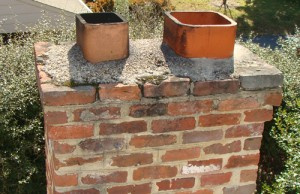 DETERIORATED MORTAR CROWN. As pictured at right, note that where the mortar crown had completely deteriorated away near the edges, the mortar between the bricks is also gone. The damage continues from the top down, when a strong wind can simply blow the top of the chimney over – onto the roof or your car below.
DETERIORATED MORTAR CROWN. As pictured at right, note that where the mortar crown had completely deteriorated away near the edges, the mortar between the bricks is also gone. The damage continues from the top down, when a strong wind can simply blow the top of the chimney over – onto the roof or your car below.
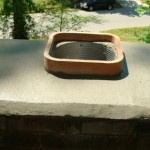 Mortar Crowns repaired or replaced. The mortar crown is a layer of mortar at the top of the chimney that’s laid on a slope so provide run-off for rain. Over time, the mortar crown will begin to crack, allowing rain to seep in. Changes in temperature, especially on a cold night with freezing temperatures, can allow the absorbed rain to turn to ice which breaks apart the mortar.
Mortar Crowns repaired or replaced. The mortar crown is a layer of mortar at the top of the chimney that’s laid on a slope so provide run-off for rain. Over time, the mortar crown will begin to crack, allowing rain to seep in. Changes in temperature, especially on a cold night with freezing temperatures, can allow the absorbed rain to turn to ice which breaks apart the mortar.
If the mortar crown simply has small cracks, it may be possible to apply a crown sealant directly on top of the old one. However, often we must remove the old mortar crown, then lay a new one. If the bricks below the crown are loose, it is essential that these bricks be tuckpointed with new mortar or torn down to the area where the chimney is structurally stable, the bricks relaid, THEN the new mortar crown is applied. A new mortar crown, properly installed by a skilled professional, will last many years.
♦ Chimney Fire Investigation
This is “glazed” creosote, which is caused by moisture in the wood. This can be from a wet woodpile, or from burning unseasoned green wood. When it first forms it is sticky like tar, but after it sits in the chimney for a while, such as throughout the summer, it becomes hard and shiny like peanut brittle.
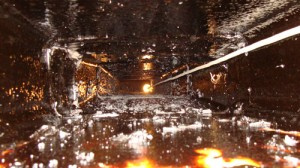 The photo at right shows “glazed” creosote, which is caused by moisture in the wood. This can be from a wet woodpile, or from burning unseasoned green wood. When it first forms it is sticky like tar, but after it sits in the chimney for a while, such as throughout the summer, it becomes hard and shiny like peanut brittle.
The photo at right shows “glazed” creosote, which is caused by moisture in the wood. This can be from a wet woodpile, or from burning unseasoned green wood. When it first forms it is sticky like tar, but after it sits in the chimney for a while, such as throughout the summer, it becomes hard and shiny like peanut brittle.
You may hear old timers talk about “burning out a chimney” in the old days as a means of cleaning the chimney. Thankfully, we now know that this is a dangerous practice that nearly always damages the chimney and sometimes catches the home on fire, too – as well as leaving a different, more flammable creosote behind to cause another fire!If you’re near the chimney when a fire occurs, it sounds like a freight train driving through the room! However, often chimney fires happen without you even knowing it. Think about how wood stove owners use their stoves; they generally add wood to the fire just before going to bed or just before leaving for work. Commonly chimney fires are ignited by a rush of air rising through the chimney and taking a stray spart with it which lands on the creosote and ignites the chimney. Opening the door to add wood to a fire provides this quick rush of air, though the chimney may not ignite until several minutes later, after you’ve left the room or left home. So on the off chance we find evidence of a chimney fire, this is why it could have happened without your knowledge.
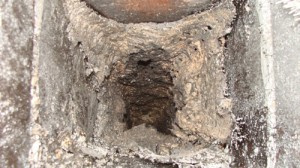 This chimney recently suffered a chimney fire. You can see the red clay tile liner near the top of the photo, and the thickness of the puffy creosote which has almost fully blocked the chimney flue.
This chimney recently suffered a chimney fire. You can see the red clay tile liner near the top of the photo, and the thickness of the puffy creosote which has almost fully blocked the chimney flue.
A chimney fire often leaves behind a different type of creosote that is puffy, almost like popcorn (as shown in the photo at left). This residue expands while it burns and can block the chimney as well as providing the fuel for a subsequent chimney fire.
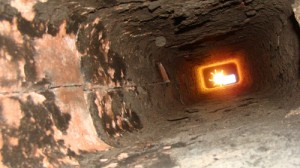
Once the chimney has been swept, we’re able to see the flue tile liners, or what’s left of them. In this photo, note that the chimney fire burned most of the creosote from the area in the left, and you can see a crack in the corner that extends all the way down. This damaged chimney liner makes the chimney unusable until the chimney is relined.
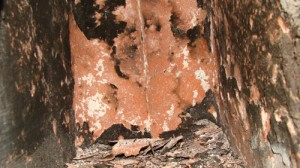
A chimney fire nearly always damages clay tile liners as you can see from the photos. Based on the type of creosote in your chimney and the particular way that clay tiles are damaged after a chimney fire, we can provide the needed photo and video documentation for your homeowners insurance if you intend to have your insurance pay for the repairs. After years of working with insurance adjustors in the Richmond area, we’re familiar with the information they need. We also provide repairs to your chimney for whatever damage it has suffered, including installation of stainless steel chimney liners.
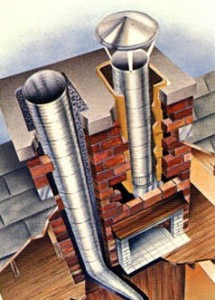 ♦ Chimney Lining / Relining
♦ Chimney Lining / Relining
Older homes had simple brick chimneys with no liners. In the Richmond area, chimneys weren’t commonly lined in new construction until 1926. The chimney liner protects the bricks inside the chimney from corrosion and protects the mortar between the bricks from deterioration. A masonry chimney cannot be built today without a tile liner, and in new construction this is usually a clay tile chimney liner – the terra cotta colored section that you should see protruding from the top of your chimney. Clay tile liners are acceptable according to code, but clay tiles are highly susceptible to damage from chimney fires and water damage. When lining an unlined chimney or relining a chimney with damaged clay liners, we most often recommend a stainless steel chimney liner, which carries a lifetime manufacturer’s warranty against corrosion and chimney fires. Stainless steel chimney liners are suitable as an “all fuel” venting system and can be used with appliances venting wood, oil or gas.
We’re members of the Better Business Bureau. REQUEST A QUOTE